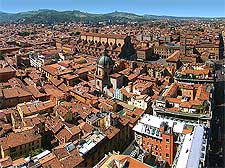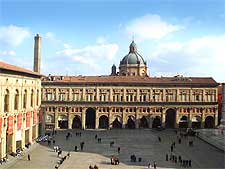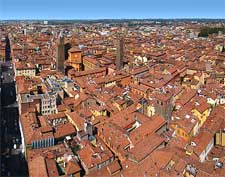Bologna History Facts and Timeline
(Bologna, Emilia-Romagna, Italy)

To uncover the history of Bologna, we really need to step back in time to the 6th century BC. Known by the Etruscans as Felsina, it was one of the most important settlements in the Po Valley. Today, there are numerous archaeological remnants of an early civilisation here.
Eventually, Bologna fell to the Romans, who set up a colony, renaming the city Bononia. Its strategic position on the ancient Via Emilia road lent it a certain prestige in the area. It is thought that Roman Bononia was home to as many as 20,000 people.
When the Roman Empire went into decline at the start of the 5th century AD, so too did the city. It was later sacked and variously occupied by groups such as the Goths, the Huns, the Lombards and the Visigoths. Nonetheless, Bologna's fortunes did revive during the centuries that followed, and it managed to slowly regain some of its former political and economic stability.

A University City
The first written testimony to the foundation of a university here dates to 1088. Today, it is widely regarded as being the oldest university in Europe. The establishment of such a place of learning was to mark the start of a long period of prosperity in the city.
Between the 12th and 14th centuries, Bologna reached the peak of its prosperity. Social reforms took place here during this period of history. Grand buildings also sprang up all over the city.
Amongst the most important were the Two Towers, which were strategically placed at the entry point to Bologna. In fact, Bologna had somewhere in the region of 100 towers at this time, all named after the families who sponsored their construction. King Enzo's Palace was built between 1244 and 1246 as an extension of the city's municipal buildings. Three years after its completion, it became the residence of King Enzo of Sardinia.
From the 16th century, Bologna was ruled by the Church State. After
Rome, it was the second-most important city. It also acquired great academic prestige, becoming one of the European centres for the studying of neo-Aristotelian literary views.

History from the 17th Century to the Present Day
During the 17th and 18th centuries, the city expanded again, extending beyond the confines of its defensive wall. It was in the mid-18th century that the Portico of San Luca was built.
In the year of 1796, Bologna was occupied by the army of Napoleon Bonaparte, soon to be Emperor of France. Under French control, the city was to become the capital of the short-lived Cispadane Republic. In the years that followed, Bologna changed hands frequently. Then, in 1861, it finally became part of the unified Kingdom of Italy.
During World War Two, Bologna came under repeated bombardment by Allied forces. Many of the city's historic areas were badly damaged. In the post-war period, Bologna quickly grew into an economic centre. Today, it is home to just under 400,000 people, including a large student population.
The city has managed to retain its prestige as a centre of culture and learning. The famous author Umberto Eco became a full professor here from 1975 onwards. In 1996, the former Italian Prime Minister Romano Prodi also became a professor in the university's Faculty of Political Science.
 To uncover the history of Bologna, we really need to step back in time to the 6th century BC. Known by the Etruscans as Felsina, it was one of the most important settlements in the Po Valley. Today, there are numerous archaeological remnants of an early civilisation here.
To uncover the history of Bologna, we really need to step back in time to the 6th century BC. Known by the Etruscans as Felsina, it was one of the most important settlements in the Po Valley. Today, there are numerous archaeological remnants of an early civilisation here.
